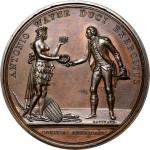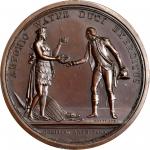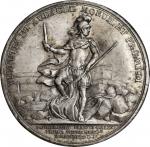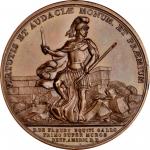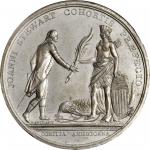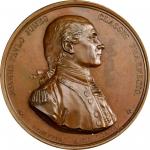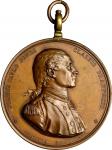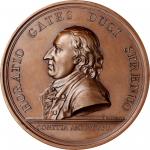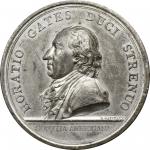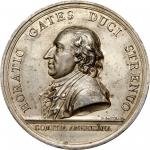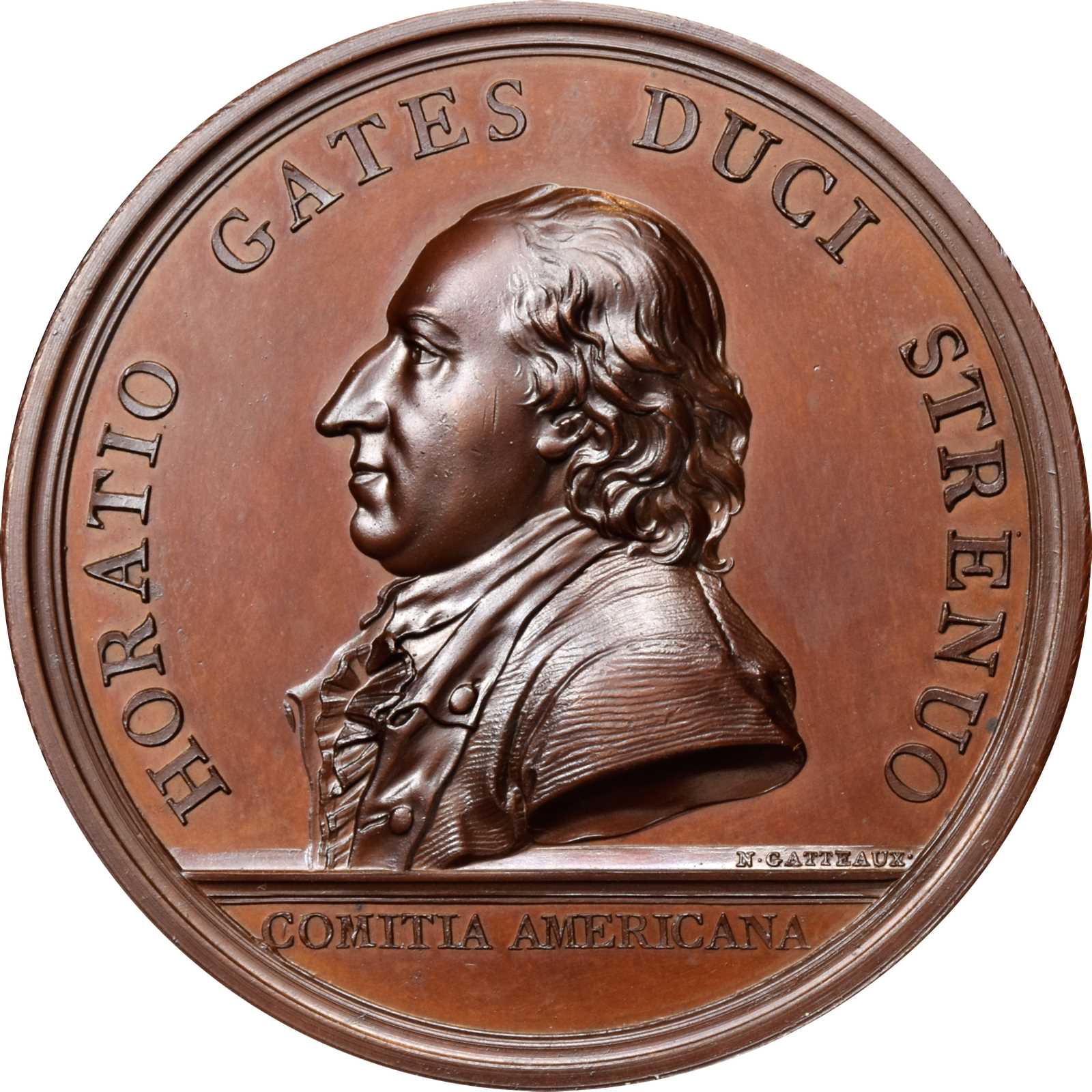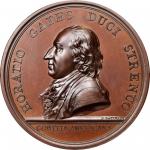1777 Horatio Gates at Saratoga medal. Betts-557, Julian MI-2. Bronze. Philadelphia Mint. Original dies. 55.6 mm, 1348.2 grains. 4.7 - 5.2 mm thick. Gem Mint State.Plain squared edge. Bronzed patina. Deep mahogany bronzing shows the best effort the Philadelphia Mint could offer. Essentially flawless, with subtle violet, gold, and blue highlights over immaculate surfaces. The obverse rim has been gently filed at the time of production to reduce the wire rim or "fin," and most of the reverse rim breaks have been similarly treated by the careful Mint personnel. This piece would have sold for $2 in 1863, though the price for U.S. Mint Gates medals dropped to $1.50 on Mint medal lists from closer to the turn of the 20th century. These dies survived until at least 1885. Julian cites a letter from Chief Engraver Charles Barber stating the original dies were still in use; only two Gates medals were struck that year. They disappear from the Mint production records until 1896, suggesting the copy reverse die - nearly identical but showing clearly different letter forms and no die breaks - had been prepared by then. This example shows significant rim breaks around most of the reverse. The rim break present in 1801, at the left side of the exergual line, has remained nearly unchanged, but additional cuds developed from just below the rim side of the exergue all the way around the circumference, counterclockwise, to above N of REGIONUM at 11:00. An adjacent retained cud is more subtle from 10:00 to 11:00. The crack from the flag through ON of SEPTENTRIONAL is advanced, creating some bowing in that area, and the central reverse has begun to swell as well. Its difficult to tell exactly when this medal was struck, though it was clearly near the end of the dies lifespan, so 1870s or 1880s is as good a guess as any. It has been stunningly well preserved since then, making this piece especially worthy of pursuit.<p><strong>The Battle of Saratoga</strong><p><p><strong>The Action:</strong><p>In the summer of 1777, the British military in North America sought to cleave the rebellious colonies in two. While Sir William Howe sailed up the Chesapeake Bay and landed troops at the Head of Elk to campaign against the rebel seat at Philadelphia, General John Burgoyne marched along the Champlain Valley water route from Canada - south via Lake Champlain, Lake George, and the Hudson River on the way to Albany. Burgoynes goal was to control the Champlain and Hudson valleys, and he endeavored to own this major north-south passage, with British held positions in Canada and New York City at either end, thereby cutting New England off from the mid-Atlantic states. Starting south across the border, Burgoynes force of nearly 8,000 consisted of about half British regulars supplemented with German mercenaries, Loyalists, and native allies. They took Fort Ticonderoga with little effort in July, but suffered a setback at the Battle of Bennington in August.<p>The Continental Army of the Northern Department, aided by the Bennington victory, saw its numbers swell in late August. Major General Horatio Gates took command on August 19, replacing Major General Phillip Schuyler. Even as Washington was charged with slowing Howes inevitable descent on Philadelphia, he saw opportunity against Burgoynes force. He sent Gates one of his most skilled officers - Benedict Arnold - along with Major General Benjamin Lincoln and the expert riflemen who served under Col. Daniel Morgan. <p>Gates first met Burgoyne at the Battle of Freemans Farm on September 19, 1777, the same week as Washingtons disaster at the Battle of Brandywine outside Philadelphia. Gates retreat preserved his force, while Burgoynes victory cost him hundreds of men. Burgoyne waited for his army to regain strength, fully expecting reinforcements to his depleted force. Gates knew his reinforcements were unlikely to appear.<p>On October 7, at the Battle of Bemis Heights, Gates and Burgoyne met once again. Gates had both superior numbers and superior intelligence; he also had Benedict Arnolds maverick plans and frenetic energy to both capitalize upon and control. Arnold led an American attack that took control of a position called the Breymann Redoubt, forcing the British troops to move. In two days, Burgoynes men found themselves hopelessly surrounded. After a weeks worth of negotiation and conversation, including a Council of War on October 13, Burgoyne agreed to surrender his entire army. Thousands of British and German troops were kept as prisoners of war, and the victory enabled Benjamin Franklin and others to successfully lobby King Louis XVI to assist the American effort.<p>Gates was proud of his role in this history-making triumph over the nation of his birth, writing to his wife on the day of the surrender "If Ole England is not by this lesson taught humility, then she is an obstinate old slut, bent upon her ruin."<p><strong>The Resolution:</strong><p><em>Resolved, That the thanks of Congress, in their own name, and in behalf of the inhabitants of the thirteen United States, be presented to Major General Gates, commander in chief in the northern department, and to Majors General Lincoln and Arnold, and the rest of the officers and troops under his command, for their brave and successful efforts in support of the independence of their country, whereby an army of the enemy of 10,000 men has been totally defeated, one large detachment of it, strongly posted and entrenched, having been conquered at Bennington, another repulsed with loss and disgrace from Fort Schuyler, and the main army of six thousand men, under Lieutenant General Burgoyne, after being beaten in different actions and driven from a formidable post, and strong entrenchments, reduced to the necessity of surrendering themselves upon advantageous to these states, on the 17 day of October last, to Major General Gates; and that a medal of gold be struck under the direction of the Board of War, in commemoration of this great event, and in the name of these United States, presented by the president to Major General Gates.</em><p><em>- Continental Congress Resolution of November 4, 1777</em><p><strong>The Acquisition:</strong><p>The day after Congress resolved to award Gates a gold medal, Henry Laurens of South Carolina wrote to the victorious general from Congress temporary seat in York, Pennsylvania in his capacity as President of Congress. <p><em>I feel myself particularly happy in the honour of transmitting the enclosed vote of thanks by Congress in their own name and in behalf of their constituents to yourself, to Major General Lincoln, Major General Arnold and the rest of the officers and troops under your command, with an additional vote for perpetuating the remembrance of this great event by a medal.</em><p><em>Your name Sir will be written in the breasts of the grateful Americans of the present age and sent down to posterity in characters which will remain indelible when the gold shall have changed its appearance. Permit me, sir, to add that I participate not only in the general rejoicing but in that also which is visible among your very best friends.</em><p>General Gates was anxious to receive his medal even before the war ended. In June 1779, he wrote again to Laurens, saying "I believe I am to wait until you are again President, before I shall receive my medal."<p>As it turned out, Gates medal was among the first for which arrangements were made. David Humphreys was the first American emissary to Paris charged with working on the Comitia Americana project, carrying instructions given by Robert Morris in June 1784. Humphreys, who served as secretary of the legation to Paris, engaged with Louis XVIs preferred medalist of the day, Nicolas-Marie Gatteaux, to execute the Gates medal. This process enters the known written recorded record in December 1785, when Jefferson is informed by Gatteaux that theres a problem with the portrait of Gates he was given: the general is depicted wearing the eagle badge of the Society of the Cincinnati, first instituted in 1784. Gatteaux wrote to Jefferson - why he didnt ask Humphreys isnt clear - if the medallic portrait of Gates should include this anachronism or not. Jefferson passed Gatteauxs query on to Humphreys on December 4, 1785:<p><em>I inclose you a letter from Gatteaux observing that there will be an anachronism, if, in making a medal to commemorate the victory of Saratoga, he puts on General Gates the insignia of the Cincinnati which did not exist at that date. I wrote him in answer that I thought so too: but that you had the direction of that business, that you were now in London, that I would write to you and probably should have an answer within a fortnight, and that in the mean time he could be employed on other parts of the die.</em><p>The exact print Gatteaux was first given is unclear, but from the portrait that Gatteaux ended up creating, its clear the eventual mother image was the popular engraving of Gates created from a portrait by Pierre Eugène du Simitière. Elvira Clain-Stefanellis suggestion that Gatteaux was initially using the extraordinarily crude engraving by John Norman seems highly unlikely.<p>The historical record on the creation of the Gates medal goes silent from the end of 1785 until early 1787, but clearly progress was being made.<p>The gold Gates medal had not been completed by the end of March when the March packet sailed for New York. On March 21, 1787, in the transmittal letter for Nathanael Greenes gold medal from William Short to John Jay, Short noted "the medal for Genl. Gates ordered by Congress and contracted for by Colo. Humphries (sic) is not yet finished; but will certainly be in time to be sent by the May Packet." The next day, in a letter to Jefferson, Short sounded less certain. "Mr. Walton who set out this morning for Havre took charge of the medals for Congress, that is those of Genl. Greene," Short wrote. "I have heard nothing farther from the engraver of Genl. Gatess."<p>Just a few days later, Short - who clearly had taken on responsibility for the Gates medal by this point - updated Jefferson again. "General Gatess medal is at length advanced to that point at which by the contract the engraver is entitled to receive 1200 [livres tournois]. I have told him I would write to you on the subject. He promises to finish it, without fail, in time to go by the May Packet. I think the likeness is very good considering the manner in which it has been taken." Jefferson forwarded an order for 1200 livres, drawn on the banker Ferdinand Grand, to Short on April 7 "for the workman who makes Genl. Gatess medal." On April 24, Short acknowledged the order had been received and paid over to Gatteaux. The deal had been completed.<p>In a wide-ranging and lengthy letter to John Jay dated May 4, 1787, Jefferson noted in his eleventh paragraph "I am in hopes Mr. Short will be able to send you the medals of General Gates by this packet. I await a general instruction as to these medals. The academies of Europe will be much pleased to receive each a set." <p>Short did not disappoint, addressing Jay the same day. "Sir, I have the honor of forwarding to your Excellency by M. de Crevecoeur the medal for Genl. Gates mentioned in my letter sent by Mr. Walter and accompanying that of Genl. Greene. M. de Crevecoeur takes charge also of twenty four medals of bronze to be delivered to your excellency. These have been made agreeably to the contract with Colo. Humphries (sic)."<p>The Gates medal was hand carried to the American continent by French writer and diplomat John Hector St. John de Crevecoeur, usually known as simply Crevecoeur, then serving as French consul at New York. Crevecoeur left Paris bound for New York on May 7, 1787, and in a letter from William Short to Jefferson the following day Short noted "Crevecoeur has gone for Havre, to sail from thence the 10th. He took with him the medals of Genl. Gates." Crevecoeur landed in New York in late June 1787 on board the Courrier de lEurope, carrying a letter of introduction to James Madison and accompanied in the passenger compartment by none other than John Paul Jones. Upon his arrival, Crevecoeur likely delivered the Gates medals - one in gold, 23 in bronze - to John Jay, who then delivered Gates own medal to Arthur St. Clair, the President of Congress.<p>Jefferson received and paid for the silver Gates medal struck for presentation to George Washington on July 4, 1789.<p><strong>The Presentation:</strong><p>The August 1787 presentation of Gates gold medal was a reunion of sorts. The medal was delivered into Gates hands by letter from Arthur St. Clair, whose abandonment of Fort Ticonderoga in July 1777 helped lead Burgoyne into Gates hands at Saratoga. Gates received St. Clairs letter of August 9, 1787 at his home, Travelers Rest, in what was then Berkeley County, Virginia and is today near Kearneysville, Jefferson County, West Virginia. He thanked St. Clair profusely on August 31, 1787.<p><em>Sir:-I had the honor to receive your Excellencys letter of the 9th inst., with the elegant medal in gold, which the most honorable the Congress, in their names, and in behalf of the inhabitants of the thirteen United States, were pleased to direct the Board of War to have struck and presented to me. Nothing could add to this distinguished mark of the favor and approbation of Congress but my receiving it in so polite a manner from the hands of your Excellency; from you, sir, whom, in the course of thirty years, I have so often had the honor to accompany on a vast variety of military service. </em><p><em>Permit me, likewise, to declare the satisfaction I feel in seeing your Excellencys merits crowned by the high station you now fill with such acknowledged ability. That the prosperity, honor, and happiness of the United States may last to the end of time, and that your Excellency may continue to enjoy the best blessings fortune can bestow, is my constant, ardent wish.</em><p><strong>The Horatio Gates at Saratoga Medal:</strong><p><strong>Obverse:</strong> A portrait of Gates to left, apparently based upon the Gates portrait by Pierre Eugène du Simitière; the dress is either civilian or intended to be military but mistakenly lacking his epaulet. Legend HORATIO GATES DUCI STRENUO (Horatio Gates, valiant general or energetic leader). COMITIA AMERICANA (American Congress) in exergue.<p><strong>Reverse:</strong> Gates upright at right, holding his hat and extending his right hand, Burgoyne on bent knee offering sword at left. Burgoynes troops, in left background, furl flags and lay down their arms. An artillery piece points away. At center background, a furled flag is laid over a drum. At right left background, American troops stand tall with shouldered arms surmounted by bayonets. A sword-wearing officer stands in front of the American line. A single flag is raised at right. At left end of the exergual line, a grouping of cannonballs. At right end, a victory laurel. Main legend SALUS REGIONUM SEPTENTRIONAL (Safety in the northern regions). In exergue, HOSTE AD SARATOGAM INDEDITION ACCEPTO DIE XVII OCT MDCCLXXVII (Advancing to the surrender of Saratoga, October 17, 1777). <p>From the John W. Adams Collection. Acquired from Frank Vivalo, October 2007.

